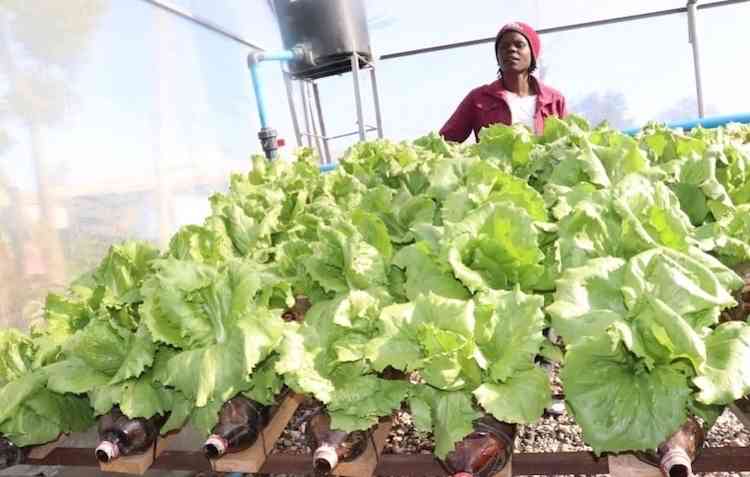
In the midst of a climate crisis that has ravaged Zimbabwe's agricultural landscape, a quiet revolution is unfolding.
Amidst the parched fields and withered crops, a beacon of hope is emerging in the form of hydroponic farming.
This innovative approach to agriculture is not only defying the odds of a changing climate, but also empowering a new generation of farmers to take control of their destiny.
As the country grapples with the devastating impacts of droughts, floods, and unpredictable weather patterns, hydroponic farming is proving to be a resilient and sustainable solution.
With its water-efficient methods, crop diversification, and entrepreneurial spirit, hydroponic farming is transforming the agricultural sector and offering a glimpse of a brighter future.
Hydroponics is a soilless cultivation technique that enables plant growth in arid or peri-urban areas.
It uses up to 90% less water and 75% less space, while producing crops that grow 100% faster than under traditional agriculture. The project uses a set of plastic pipes, buckets, a solar pump and plant solution which contains plant nutrients.
What sets Zimbabwe's hydroponic farming apart is not just the technology itself, but the way it has been embraced and adapted to the unique challenges facing the country.
- Innovative farming transforms refugees’ lives
- Feature:Inside refugee camp using solar power, hydroponics to grow fruit
- Village Rhapsody: How Zimbabwe's hydroponic farming is a beacon of hope in the face of climate change
- Innovating human centred education, research in Zim
Keep Reading
In a country where droughts have become increasingly common, and water scarcity is a pressing concern, this method of farming offers a sustainable solution that minimizes water usage while maximizing productivity.
One of the key advantages of hydroponic farming is its resilience to environmental fluctuations.
Traditional farming practices rely heavily on consistent rainfall, arable land, and favourable weather conditions, all of which have become increasingly unpredictable due to climate change.
Hydroponic systems, on the other hand, are largely self-contained, allowing farmers to control the growing environment and minimize the impact of external factors.
Moreover, hydroponic farming is not just a lifeline for food production; it is also a catalyst for economic empowerment and social upliftment.
In Zimbabwe, where access to land and resources has been a pervasive challenge, especially for marginalised communities, hydroponic farming has emerged as a viable option for small-scale and urban farmers.
By providing a means to cultivate nutrient-rich produce in confined spaces, this technology has opened up new avenues for entrepreneurship and job creation, particularly in urban areas where land is scarce.
The El Nino-induced drought has not only affected the rural communities but also the urban communities are also going through the same fate.
It is against this background that a number of organisations, including the World Food Programme (WFP) have come up with initiatives meant to build resilience among urban communities.
WFP has introduced the hydroponic project in Alaska Mine on the outskirts of Chinhoyi where the organisation built a greenhouse and set up a solar-powered borehole.
During my look and learn experience with the WFP in Chinhoyi where they introduced the hydroponic system I noticed that one of the key advantages of hydroponic farming is its resilience to environmental fluctuations.
Traditional farming practices rely heavily on consistent rainfall, arable land, and favourable weather conditions, all of which have become increasingly unpredictable due to climate change.
Hydroponic systems, on the other hand, are largely self-contained, allowing farmers to control the growing environment and minimize the impact of external factors.
Eight families are benefitting from the project which mainly produces spinach and tomatoes.
Hazvinei Tembo (30), one of the beneficiaries, expressed her joy over the project.
“The greenhouse is helping us get access to healthy food,” Tembo said.
“The vegetables we harvest from this greenhouse generate about US$216 per table, this however keeps us going.
“We are grateful for the borehole that was drilled for us because water has been a challenge.
“We used to walk long distances to fetch water from the dam.
“Right now, from this project I am able to get money to buy food, pay my rent and school fees for my children.”
Tembo said they were supplying their produce to Chinhoyi town and nearby communities as they wait for a license to supply to retailers.
The greenhouse is not only beneficiary to the few families; it is also used by students at Alaska High School.
Although the concept is new in Zimbabwe, a number of countries in arid-prone areas such the Algerian and Chadian Sahara desert, the slums of Lima (Peru), Syrian refugee camps in Jordan as well as schools in Zambia.
The success of Zimbabwe's hydroponic farming initiatives has not gone unnoticed. Within the country, these projects have gained the attention of policymakers, who have recognized the potential of this approach to address the nation's pressing food security concerns.
The government has invested in research, training, and infrastructure to support the growth of this sector, ensuring that the benefits of this technology are accessible to a wider population.
Beyond Zimbabwe's borders, the global community has taken note of the country's innovative strides in hydroponic farming. International organisations and development agencies have partnered with Zimbabwean stakeholders, sharing knowledge, resources, and best practices to further strengthen and scale up these initiatives.
This collaborative approach has not only bolstered the resilience of Zimbabwe's agricultural sector, but has also positioned the country as a beacon of hope for other nations grappling with the consequences of climate change.
As the world grapples with the increasingly dire realities of a changing climate, the success of Zimbabwe's hydroponic farming serves as a powerful reminder that solutions do exist.
By harnessing the power of technology, embracing innovation, and fostering community-driven initiatives, we can overcome the challenges posed by climate change and secure a more sustainable future for all.
In the face of daunting environmental challenges, Zimbabwe's hydroponic farming stands as a testament to the human spirit – a testament to resilience, ingenuity, and the unwavering determination to overcome adversity.
As the global community looks for innovative ways to ensure food security and build climate-resilient agricultural systems, Zimbabwe's story offers a glimmer of hope, a shining example of what can be achieved when we dare to dream and act with purpose.









